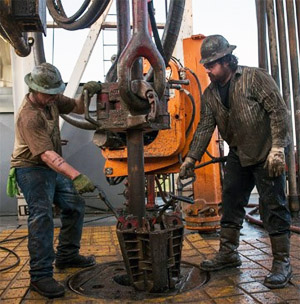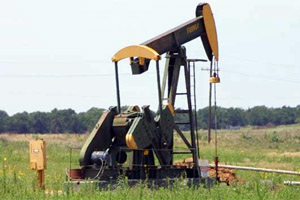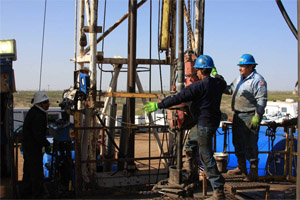 State legislation filed today by a Democrat lawmaker would assess a nickel-per-barrel fee on all “deleterious substances” pumped into any commercial injection or disposal well in Oklahoma.
State legislation filed today by a Democrat lawmaker would assess a nickel-per-barrel fee on all “deleterious substances” pumped into any commercial injection or disposal well in Oklahoma.
House Bill 1330 by Minority Floor Leader Rep. David Perryman (D-Dist. 56) defines “deleterious substances” to include “any chemical, saltwater, oil field brine, waste oil, waste emulsified oil, basic sediment, mud or injurious substances produced or used in the drilling, development, production, transportation, refining and processing of oil, gas or brine mining.”
 Operators of commercial disposal wells in this state would be required by HB 1330 to maintain logs of all loads of deleterious substances disposed at their wells. The information would have to include the amount received, the location of the source, and the operator/owner of the source of the “deleterious substance”.
Operators of commercial disposal wells in this state would be required by HB 1330 to maintain logs of all loads of deleterious substances disposed at their wells. The information would have to include the amount received, the location of the source, and the operator/owner of the source of the “deleterious substance”.
A disposal fee of a nickel per barrel of oilpatch wastewater would have generated $77 million in both 2014 and 2015. HB 1330 does not specify how the revenue from the proposed disposal fee would be allocated.
Literally “an ocean” of saltwater and wastewater from oil and gas exploration/production has been pumped into disposal wells in Oklahoma in recent years, Democrat Party activist Richard Morrissette, a former legislator, noted.
Perryman noted that millions of gallons of that wastewater originates outside of Oklahoma, and neither the saltwater nor the production that caused it generates revenue for this state. Oklahoma Corporation Commission (OCC) records show that commercial disposal well operators in Oklahoma accepted 2.44 million barrels of saltwater (102 million gallons) from oil/gas activities in five neighboring states – Texas Kansas, Arkansas, New Mexico and Colorado – in 2015.
 HB 1330 provides that if the wastewater is generated from an Oklahoma oil or gas well on which gross production taxes would be paid, the operator could reduce the amount of gross production taxes due by the amount of nickel-per-barrel fees paid. Consequently, Oklahoma oil and gas wells that already generate gross production taxes for the state would not be required to pay additional taxes after the credit was applied.
HB 1330 provides that if the wastewater is generated from an Oklahoma oil or gas well on which gross production taxes would be paid, the operator could reduce the amount of gross production taxes due by the amount of nickel-per-barrel fees paid. Consequently, Oklahoma oil and gas wells that already generate gross production taxes for the state would not be required to pay additional taxes after the credit was applied.
“Oklahoma should not be serving as the repository for out-of-state wastewater and having to cope with seismic activity caused in part by out-of-state wastewater injection, and not receive any revenue as a result of the disposal of out-of-state wastewater,” Perryman asserted.
Naturally occurring saltwater, also known as “produced” water and “fossil” water, is a by-product of oil and gas exploration.
A typical well in Oklahoma produces about 10 barrels of saltwater for every barrel of oil. However, Arnella Karges, executive vice president of the Oklahoma Oil and Gas Association, said during a legislative study Oct. 25 at the State Capitol that wells in the Mississippi Lime Formation sometimes produce 50 to 100 barrels of brine for every barrel of oil extracted.
According to records of the Corporation Commission, which regulates the energy industry in this state, more than 1.5 billion 42-gallon barrels of produced water were injected into Oklahoma disposal wells in 2014 and again in 2015.
 OCC records reflect that 6.37 billion barrels of oilfield waste (267 billion gallons of fluid) were injected into Oklahoma disposal wells in the five-year period of 2011-15. That volume is equivalent to 11 Lake Hefners, three and a half Sardis lakes, nearly two Kaw lakes, six and a half Lugert-Altus lakes, or two and a half Fort Gibson lakes.
OCC records reflect that 6.37 billion barrels of oilfield waste (267 billion gallons of fluid) were injected into Oklahoma disposal wells in the five-year period of 2011-15. That volume is equivalent to 11 Lake Hefners, three and a half Sardis lakes, nearly two Kaw lakes, six and a half Lugert-Altus lakes, or two and a half Fort Gibson lakes.
Energy producers currently pump this wastewater into injection wells that extend a mile or more belowground.
OCC ledgers list 195,000 wells in Oklahoma that are classified as “active.” Of those, the commission has issued permits for approximately 4,500 Class II wastewater disposal wells, and, on average, about 3,200 of them are in operation in any given year, Skinner has said.
Approximately 1,000 of those disposal wells penetrate the subterranean Arbuckle Formation. In an effort to reduce seismic activity – earthquakes – the Corporation Commission has shut down or scaled back operations at approximately 700 of those disposal wells, which are situated in a 15,000 square-mile seismically active “area of interest” that extends across northern, central and northwestern Oklahoma.
 Volume meters and pressure gauges have been installed on all of the disposal wells in the Arbuckle area-of-interest, Skinner said. The Corporation Commission requires operators of disposal wells in the Arbuckle area-of-interest to report volumes once a week, “at a minimum,” while the others across the state are obligated to report just once a year, Skinner said. “The annuals are not due until April,” he added.
Volume meters and pressure gauges have been installed on all of the disposal wells in the Arbuckle area-of-interest, Skinner said. The Corporation Commission requires operators of disposal wells in the Arbuckle area-of-interest to report volumes once a week, “at a minimum,” while the others across the state are obligated to report just once a year, Skinner said. “The annuals are not due until April,” he added.
